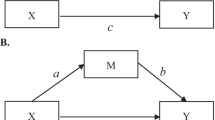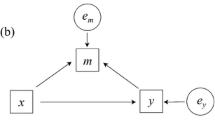Abstract
Mediation analysis is a methodology used to understand how and why behavioral phenomena occur. New mediation methods based on the potential outcomes framework are a seminal advancement for mediation analysis because they focus on the causal basis of mediation. Despite the importance of the potential outcomes framework in other fields, the methods are not well known in prevention and other disciplines. The interaction of a treatment (X) and a mediator (M) on an outcome variable (Y) is central to the potential outcomes framework for causal mediation analysis and provides a way to link traditional and modern causal mediation methods. As described in the paper, for a continuous mediator and outcome, if the XM interaction is zero, then potential outcomes estimators of the mediated effect are equal to the traditional model estimators. If the XM interaction is nonzero, the potential outcomes estimators correspond to simple direct and simple mediated contrasts for the treatment and the control groups in traditional mediation analysis. Links between traditional and causal mediation estimators clarify the meaning of potential outcomes framework mediation quantities. A simulation study demonstrates that testing for a XM interaction that is zero in the population can reduce power to detect mediated effects, and ignoring a nonzero XM interaction in the population can also reduce power to detect mediated effects in some situations. We recommend that prevention scientists incorporate evaluation of the XM interaction in their research.


Similar content being viewed by others
References
Aiken, L. S., & West, S. G. (1991). Multiple regression: Testing and interpreting interactions. Newbury Park: Sage.
Bradley, J. V. (1978). Robustness? British Journal of Mathematical and Statistical Psychology, 31, 144–152.
Chiolero, A. (2018). Data are not enough – Hooray for causality! American Journal of Public Health, 108, 622.
Coffman, D. L., MacKinnon, D. P., Zhu, Y., & Ghosh, D. (2016). A comparison of potential outcomes approaches for assessing causal mediation. In H. He, P. Wu, & D.-G. Chen (Eds.), Statistical Causal Inferences and Their Applications in Public Health Research (pp. 263–293). Springer.
Cohen, J. (1988). Statistical power for the behavioral sciences. Hillsdale: Erlbaum.
Cohen, J., Cohen, P., West, S. G., & Aiken, L. S. (2003). Applied multiple regression/correlation analysis for the behavioral sciences (3rd ed.). Mahwah: Lawrence Erlbaum Associates, Inc..
Flora, D. B., & Curran, P. J. (2004). An empirical evaluation of alternative methods of estimation for confirmatory factor analysis with ordinal data. Psychological Methods, 9, 466–491.
Glymour, M. M., & Hamad, R. (2018). Causal thinking as a critical tool for eliminating social inequalities in health. American Journal of Public Health, 108, 623.
Goldberg, L., MacKinnon, D. P., Elliot, D., Moe, E., Clarke, G., & Cheong, J. (2000). The adolescents training and learning to avoid steroids program: Preventing drug use and promoting health behaviors. Archives of Pediatrics and Adolescent Medicine, 154, 332–338.
Hernán, M. (2018). The C-word: Scientific euphemisms do not improve causal inference from observational data. American Journal of Public Health, 108, 616–619.
Holland, P. W. (1986). Statistics and causal inference. Journal of the American Statistical Association, 81, 945–960.
Holland, P. W. (1988). Causal inference, path analysis, and recursive structural equations models. Sociological Methodology, 18, 449–484.
Ikram, M. A., & VanderWeele, T. J. (2015). A proposed clinical and biological interpretation of mediated interaction. European Journal of Epidemiology, 30, 1115–1118.
Imai, K., Keele, L., & Tingley, D. (2010). A general approach to causal mediation analysis. Psychological Methods, 15, 309–334.
Jo, B. (2008). Causal inference in randomized experiments with mediational process. Psychological Methods, 13, 314–336.
Judd, C. M., & Kenny, D. A. (1981). Process analysis: Estimating mediation in treatment evaluations. Evaluation Review, 5, 602–619.
Kraemer, H. C., Kiernan, M., Essex, M., & Kupfer, D. J. (2008). How and why criteria defining moderators and mediators differ between the Baron & Kenny and MacArthur approaches. Health Psychology, 27, S101–S108.
Liu, W., Kuramoto, S. K., & Stuart, E. A. (2013). An introduction to sensitivity analysis for unobserved confounding in non-experimental prevention research. Prevention Science, 14, 570–580.
MacKinnon, D. P. (2008). Introduction to statistical mediation analysis. New York: Lawrence Erlbaum.
MacKinnon, D. P., & Pirlott, A. (2015). Statistical approaches to enhancing the causal interpretation of the M to Y relation in mediation analysis. Personality and Social Psychology Review, 19, 30–43.
MacKinnon, D. P., Krull, J. L., & Lockwood, C. M. (2000). Equivalence of the mediation, confounding, and suppression effect. Prevention Science, 1, 173–181.
MacKinnon, D. P., Goldberg, L., Clarke, G. N., Elliot, D. L., Cheong, J., Lapin, A., Moe, E. L., & Krull, J. L. (2001). Mediating mechanisms in a program to reduce intentions to use anabolic steroids and improve exercise self-efficacy and dietary behavior. Prevention Science, 2, 15–28.
MacKinnon, D. P., Lockwood, C. M., Hoffman, J. M., West, S. G., & Sheets, V. (2002). A comparison of methods to test mediation and other intervening variable effects. Psychological Methods, 7, 83–104.
McDonald, R. P. (1997). Haldane’s lungs: A case study in path analysis. Multivariate Behavioral Research, 32, 1–38.
Merrill, R. M. (1994). Treatment effect evaluation in nonadditive mediation models. Unpublished doctoral dissertation, Arizona State University.
Morgan-Lopez, A. A., & MacKinnon, D. P. (2006). Demonstration and evaluation of a method to assess mediated moderation. Behavior Research Methods, 38, 77–87.
Muthén, B., & Asparouhov, T. (2015). Causal effects in mediation modeling: An introduction with applications to latent variables. Structural Equation Modeling: A Multidisciplinary Journal, 22, 12–23.
Pearl, J. (2001). Direct and indirect effects. In J. Breese & D. Koller (Eds.), Proceedings of the 17th Conference on Uncertainty in Artificial Intelligence (pp. 411–420). San Francisco: Morgan Kaufmann.
Pearl, J. (2012). The causal mediation formula - a guide to the assessment of pathways and mechanisms. Prevention Science, 13, 426–436.
Pearl, J. (2014). Interpretation and identification of causal mediation. Psychological Methods, 19, 459–481.
Pearl, J., & MacKenzie, D. (2018). The book of why: The new science of cause and effect. New York: Basic Books.
Robins, J. M., & Greenland, S. (1992). Identifiabilty and exchangeability for direct and indirect effects. Epidemiology, 3, 143–155.
Rubin, D. B. (1974). Estimating causal effects of treatments in randomized and nonrandomized studies. Journal of Educational Psychology, 66, 688–701.
Stuart, E. A., Bradshaw, C. P., & Leaf, P. J. (2015). Assessing the generalizability of randomized trial results to target populations. Prevention Science, 16, 475–485.
Valeri, L., & VanderWeele, T. J. (2013). Mediation analysis allowing for exposure-mediator interactions and causal interpretation: Theoretical assumptions and implementation with SAS and SPSS macros. Psychological Methods, 18, 137–150.
VanderWeele, T. J. (2014). A unification of mediation and interaction: A 4-way decomposition. Epidemiology, 25, 749–761.
VanderWeele, T. (2015). Explanation in causal inference: Methods for mediation and interaction. New York: Oxford University Press.
VanderWeele, T. J., & Vansteelandt, S. (2009). Conceptual issues concerning mediation, interventions and composition. Statistics and its Interface (Special Issue on Mental Health and Social Behavioral Science), 2, 457–468.
Funding
This research was supported in part by the National Institute on Drug Abuse (R37DA09757 and F31DA043317) and the National Science Foundation Graduate Research Fellowship under Grant No. DGE-1311230.
Author information
Authors and Affiliations
Corresponding author
Ethics declarations
Conflict of Interest
The authors declare that they have no conflicts of interest.
Ethical Standards
All procedures, including the informed consent process, were conducted in accordance with the ethical standards of the responsible committee on human experimentation (institutional and national) and with the Helsinki Declaration of 1975, as revised in 2000.
Informed Consent
Data were collected via informed consent in accordance with the ethical standards of the responsible committee on human experimentation (institutional and national) and with the Helsinki Declaration of 1975, as revised in 2000.
Additional information
Publisher’s Note
Springer Nature remains neutral with regard to jurisdictional claims in published maps and institutional affiliations.
Electronic Supplementary Material
ESM 1
(DOCX 121 kb)
Rights and permissions
About this article
Cite this article
MacKinnon, D.P., Valente, M.J. & Gonzalez, O. The Correspondence Between Causal and Traditional Mediation Analysis: the Link Is the Mediator by Treatment Interaction. Prev Sci 21, 147–157 (2020). https://doi.org/10.1007/s11121-019-01076-4
Published:
Issue Date:
DOI: https://doi.org/10.1007/s11121-019-01076-4




